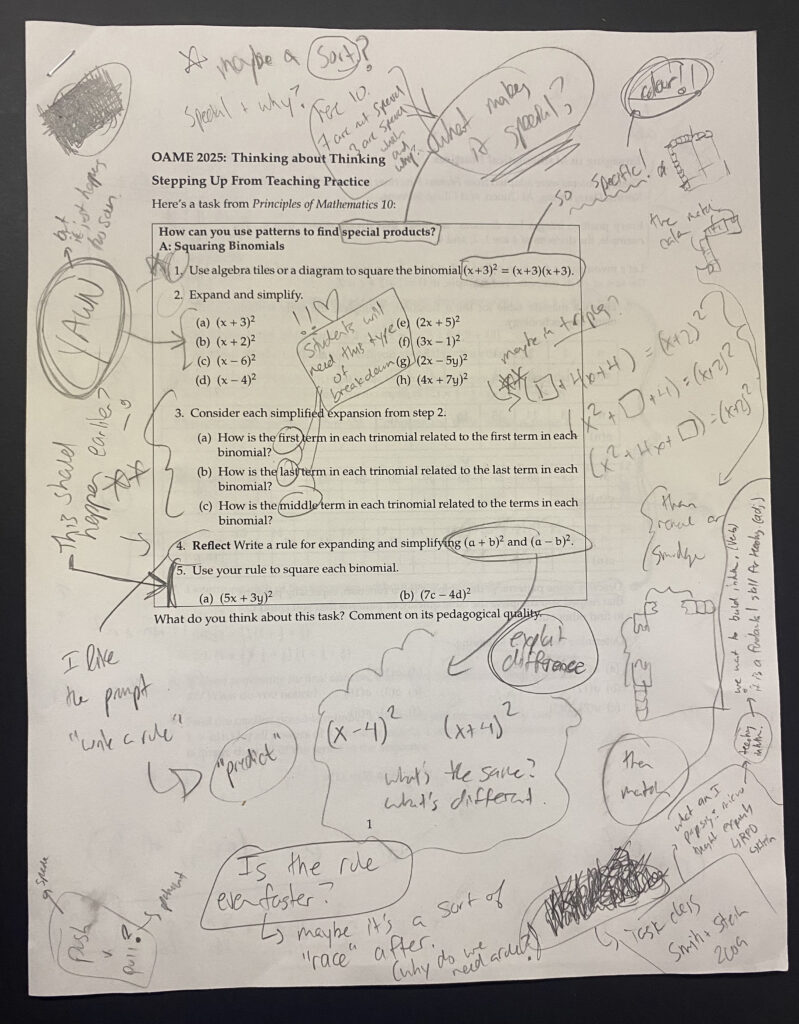I am a compulsive problem poser. When presented with a mathematical context, I have an incredible amount of difficulty leaving it alone. My teacher instinct is to push, prod, tinker, and/or alter it in someway. As I do so, I wonder what students might do and what new actions might be sponsored by any changes.
Problems are sandboxes and playing in them is a sort of imagination fuel for teaching.
This often makes me a terrible conference attendee. Usually, I get nerd-sniped by a problem and end up on some distant dendrite in a solitary thought experiment of how it might live in my classroom amongst my young mathematicians. (This, actually, is how Fraction Talks and #MenuMath started many years ago). This exact thing happened to me at an OAME2025 session where I was given a handout and it ended up looking like this.
The point here isn’t to go through how I altered this specific problem, although you may be able to make sense of some of my chicken scratches. The point here is to present this process of tinkering as a productive teaching habit, and to encourage you to do the same with problems you encounter.
How are students invited into the context? What are they asked to do? What are they given to work with? What mathematical decisions must they make? What are they asked to figure out on their own? How might their ideas collide in the classroom? etc. etc. etc.
The more I reflect on my urge to engage in problem makeovers1, the more I convince myself of its importance for math teachers.
Here’s why:
1. It puts teachers in charge
Problems found in textbooks are not ordained relics, free from blemish. They are options, and playing around with options builds our understanding, as teachers, of what sorts of options might elicit what sorts of mathematical activity. Tinkering builds teacher agency.
2. It draws our attention to difference
In any thinking act, we gain information about our context by paying attention to the differences that make differences2. When we shift a portion of a problem and consider its impact, we gain information that informs our practice and pedagogies. Sitting in the suspense of “before and after” provides a potent propellant for thinking about the teaching and learning of mathematics.
3. It expresses our intuitions
As mentioned at the onset, I often feel like I can’t help but tinker with problems. Initially, I also couldn’t effectively describe the rhyme or reason behind my edits; they felt spontaneous and intuitive. After some iteration, I now recognize some of the patterns in my process, and recognizing these allows me to more efficiently purse the types of lessons I want for my students. Posing new variations of problems, in a way, provides a portrait of what I intuitively value as a mathematics teacher, and this is a very important portrait to possess.
I suppose it’s important to point out that I don’t think a “perfect” or “best” version of a mathematical context exists. Each version, however, foregrounds certain student actions. Every context contains possibilities, and playing with the parameters develops a teacher’s ability to curate what might be possible in their classrooms. So while I can’t say that practice makes perfect, I advocate for this tinkering as a productive professional practice not because “practice makes perfect,” but, rather, because “practice makes possibilities“.
NatBanting
- This term is a specific homage to Dan Meyer‘s popular hashtag “#MakeoverMondays” where he’d invite teachers weekly to engage in this sort of activity on Twitter.
- An aggressive paraphrase of Gregory Bateson.
